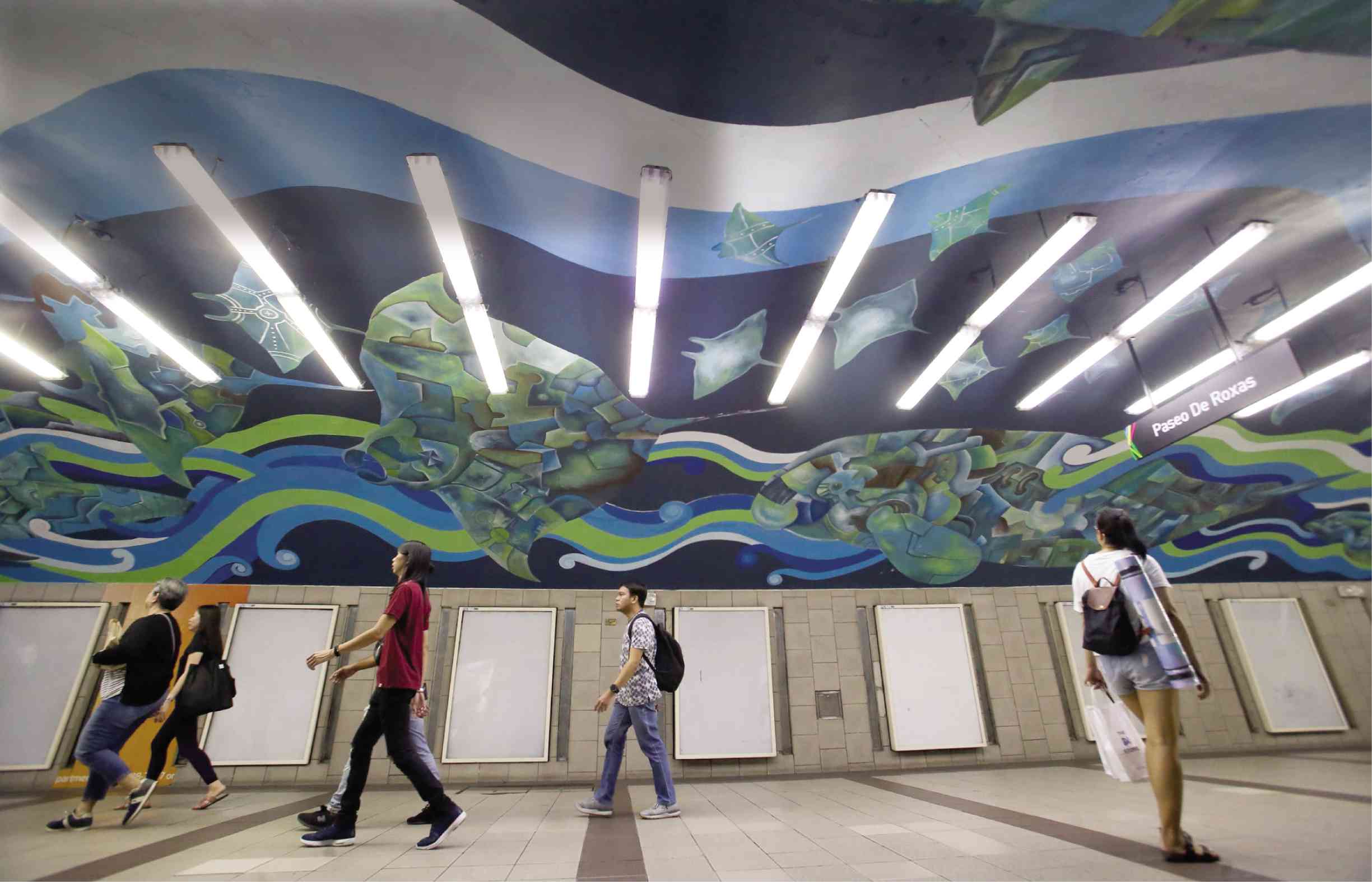Crusade to save sea creatures goes to city underpass

Credit to Author: cmiranda| Date: Sun, 16 Jun 2019 23:01:38 +0000
MANILA, Philippines — Beneath the towering buildings in the country’s financial district, pods of dolphins ride the waves with sea turtles and hammerhead sharks, blissfully unmindful of the bustling world above them.
Hundreds of kilometers away from home, these endangered creatures have appeared in one of the busiest underpasses in Metro Manila, hoping to catch even a glimpse of the thousands of passersby who go about their daily lives.
At least, this was what artist AG Saño had in mind when he sought to fill the ceiling of the Paseo de Roxas underpass in Makati City with images of sea and terrestrial animals.
With hues of blue and green, his yet unfinished work offers a striking contrast from the gray concrete and steel overhead.
Clad in armor
This time, however, his art came with an unusual touch.
While free to roam the vastness of the pedestrian tunnel, the animals were clad in armor, bringing a message that Saño hopes would reverberate across the urban jungle.
Instead of simply depicting animals in their natural habitats, he decided to clad them in metal, a symbol of an artificial protection that the species now seemingly need in order to survive.
“The damage that humans are doing to the oceans and their homes are so severe that their natural defense mechanisms would not be enough to save themselves,” he said in an interview with the Inquirer.
“In these drastic times, I want to send the message that we need to do more to help them,” he said.
Muralist’s mission
In 2010, after he had learned of the mass capture and slaughter of dolphins in Japan for human entertainment, Saño went on a crusade to memorialize every cetacean that had suffered in human hands.
“We embarked on a mission to paint one dolphin for every captured one,” said the 43-year-old muralist, who also survived the wrath of Supertyphoon “Yolanda” (international name: Haiyan) in 2013.
“We ended up painting 35,000 dolphins in 16 countries,” he said.
Creating the Dolphins Love Freedom Movement with fellow advocates and volunteers, his works became easily recognizable.
On walls that stretch along the metro’s busiest roads to otherwise empty spaces on school grounds, the freedom-loving dolphins swam happily, away from the horrors they face in the oceans.
Human threats
But nearly a decade since, the threats to these endangered animals continue at an unprecedented rate, mostly due to human activities.
A landmark report by the United Nations released in May said a million species may be pushed to extinction in the next few years.
Identified as major drivers of species decline were land conversion, overfishing, poaching, climate change and pollution.
“We are eroding the very foundations of our economies, livelihoods, food security, health and quality of life worldwide,” said Sir Robert Watson, chair of the Intergovernmental Science-Policy Platform on Biodiversity and Ecosystem Services, which conducted the global assessment.
While the Philippines remains a biodiversity hot spot, the man-made threats to its ecosystems remain a daunting challenge for both the government and environmental advocates.
Species only found in the country, including those that Saño painted in the Paseo underpass, are at risk of being wiped out if not protected.
People’s attention
By making them visible in an area where millions pass by every day, Saño hopes to capture the people’s attention to their plight.
“I like painting realist or cartoon-style images of nature, but I realized in the past three years that there are more questions raised in artworks done differently,” he said.
Commissioned by a local bank that serves as the caretaker of the underpass, Saño and his small team of volunteers began their work earlier this month, mostly working at nighttime when the rush hour has died down.
Their work in the 740-square-meter ceiling—the biggest one that Saño has worked on—mirrored the conditions when Michaelangelo painted the ceiling of the Sistine Chapel in the 1500s.
Only instead of a quiet church, they dip their brushes and rollers amid the hustle of pedestrians underneath Ayala Avenue.
Despite working during the “graveyard shift” until 4 a.m. on weekdays, a steady stream of people continue to pass through the underpass, many of them young professionals.
Some of them stop momentarily to observe the artists, take a few photos with their mobile phones, before heading back to their jobs.
Donna Madrid, who works at a nearby accounting firm, glanced up at the armored dugong and Irrawaddy dolphin above her, as she headed out toward Ayala Triangle.
A different view
For the past three years, space-themed art had occupied the ceiling, Madrid noted, so she was excited to see the changes in her usual route to work.
“It’s nice to have these kinds of artwork in the city, it’s very refreshing to the eyes,” she said. “Before I head out back to the sight of the buildings, when I head down here, at least it’s a different view.”
An image of a humpback whale stretching 1.8 meters greets those who enter the underpass from the Ayala Triangle side.
Those coming in from the other end are welcomed by a display of birds and mammals, including the “haring ibon,” the Philippine Eagle.
Jowee Maglente, a fresh graduate who landed a job in Makati City, said she found the mural attractive, noting that they do not have similar artworks in her hometown in Laguna province.
“I was really at awe at how fast they were able to do this,” she said, craning her neck to check the details overhead. “Not only is it nice to look at, but it also raises awareness to save our nature.”